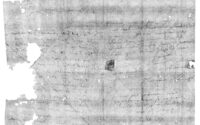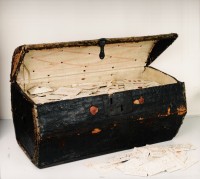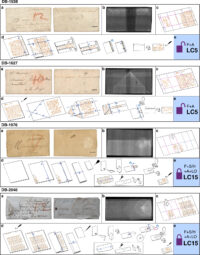X-ray microtomography (XMT), a scanning technology used in dental research, has virtually opened a letter that has been securely closed for 300 years. The technology more intense X-rays than CT scanners that are able to read the metals — iron, copper, mercury — in traditional inks. Once the volumetric dataset was produced, computer modeling was able to “unfold” the letter without damaging the document itself.
 Dated July 31, 1697, the letter was written by Jacques Sennacques of Lille to his cousin Pierre Le Pers, a merchant in The Hague, asking for a relative’s death certificate in flowery prose that fails to mask his impatience at how long cousin Pierre has been ghosting him.
Dated July 31, 1697, the letter was written by Jacques Sennacques of Lille to his cousin Pierre Le Pers, a merchant in The Hague, asking for a relative’s death certificate in flowery prose that fails to mask his impatience at how long cousin Pierre has been ghosting him.
Dear sir & cousin,
It has been a few weeks since I wrote to you in order to ask you to have drawn up for me a legalized excerpt of the death of sieur Daniel Le Pers, which took place in The Hague in the month of December 1695, without hearing from you. This is {…} I am writing to you a second time in order to remind you of the pains that I took on your behalf. It is important to me to have this extract you will do me a great pleasure to procure it for me to send me at the same time news of your health of all the family.
I also pray that God maintains you in His Sainted graces & covers you with the blessings necessary to your salvation. Nothing more for the time being, except that I pray you to believe that I am completely, sir and cousin, your most humble & very obedient servant,
Jacques Sennacques
I beg you to send your response to Mr Sennacques, king’s councillor in the bailiwick of Lille, Rue St Etienne in Lille
From Lille, the 31st of July 1697
The intricate folding of letters so they become their own secured envelopes, a practice known as letterlocking, was widely used before the introduction of the Uniform Penny Post spearheaded by reformer Rowland Hill in 1840 and the invention of the first machine to fold and gum envelopes by his brother and Controller of Stamps Edwin Hill. The folding methods could be incredibly complex, some with tabs and adhesives to deter any unauthorized attempt to open a letter. Before this study, the only way historians could read locked letters was to cut them open.
X-rays have been used before to scan historical documents for hidden or illegible text, but they were either single layer documents like scrolls and pages of books, or were folded once or twice and most. The letterpackets are far more complex, folded many times in multiple directions and often creating dense layers of text.
 The four letterpackets examined in the study are part of a great collection of undelivered mail recently rediscovered in the Museum voor Communicatie in The Hague. The wooden trunk lined with waterproof sealskin belonged to The Hague postmaster Simon de Brienne and his wife, deputy postmaster Marie Germain, who together were responsible for delivering mail to recipients in The Hague. At the time, recipients paid postage, which was determined based on number of pages and distance, and if a letter was refused or the addressee was dead or could not be reached for whatever reason, the letters were supposed to be returned. The Briennes saved them, hoping that somebody would eventually claim them and pay the charges owing.
The four letterpackets examined in the study are part of a great collection of undelivered mail recently rediscovered in the Museum voor Communicatie in The Hague. The wooden trunk lined with waterproof sealskin belonged to The Hague postmaster Simon de Brienne and his wife, deputy postmaster Marie Germain, who together were responsible for delivering mail to recipients in The Hague. At the time, recipients paid postage, which was determined based on number of pages and distance, and if a letter was refused or the addressee was dead or could not be reached for whatever reason, the letters were supposed to be returned. The Briennes saved them, hoping that somebody would eventually claim them and pay the charges owing.
In his will, Brienne bequeathed his earthly goods to the administrators of estates of Delft until his descendant should “renounce the errors of the Roman church,” convert to Protestantism and move to Holland. They never did, so the trunk stayed in government hands until the estate was finally liquidated in 1922. The trunk entered the collection of the newly-created museum in 1926.
 Since then, a few of the letters were accessed by researchers, a few more went on display on occasion and the assemblage was partially catalogued, it was not generally known until 2012 when it was rediscovered by scholars researching the lives of French actors and Huguenot exiles in the Dutch Republic. It contains 3,148 letters sent between 1689 and 1707 from France, Spain, Flanders and Brabant. The senders represent a vast cross-section of professions and classes, from dukes to merchants, actors to spies, refugees to ambassadors, and are written in English, Dutch, Spanish, Italian, Danish, French and Latin. Of the letters in the trunk, 577 are unopened letterpackets.
Since then, a few of the letters were accessed by researchers, a few more went on display on occasion and the assemblage was partially catalogued, it was not generally known until 2012 when it was rediscovered by scholars researching the lives of French actors and Huguenot exiles in the Dutch Republic. It contains 3,148 letters sent between 1689 and 1707 from France, Spain, Flanders and Brabant. The senders represent a vast cross-section of professions and classes, from dukes to merchants, actors to spies, refugees to ambassadors, and are written in English, Dutch, Spanish, Italian, Danish, French and Latin. Of the letters in the trunk, 577 are unopened letterpackets.
The study has been published in Nature Communications and can be read here (pdf). Explore the Brienne Collection on the Signed, Sealed & Undelivered website dedicated to this treasury of early modern correspondence.